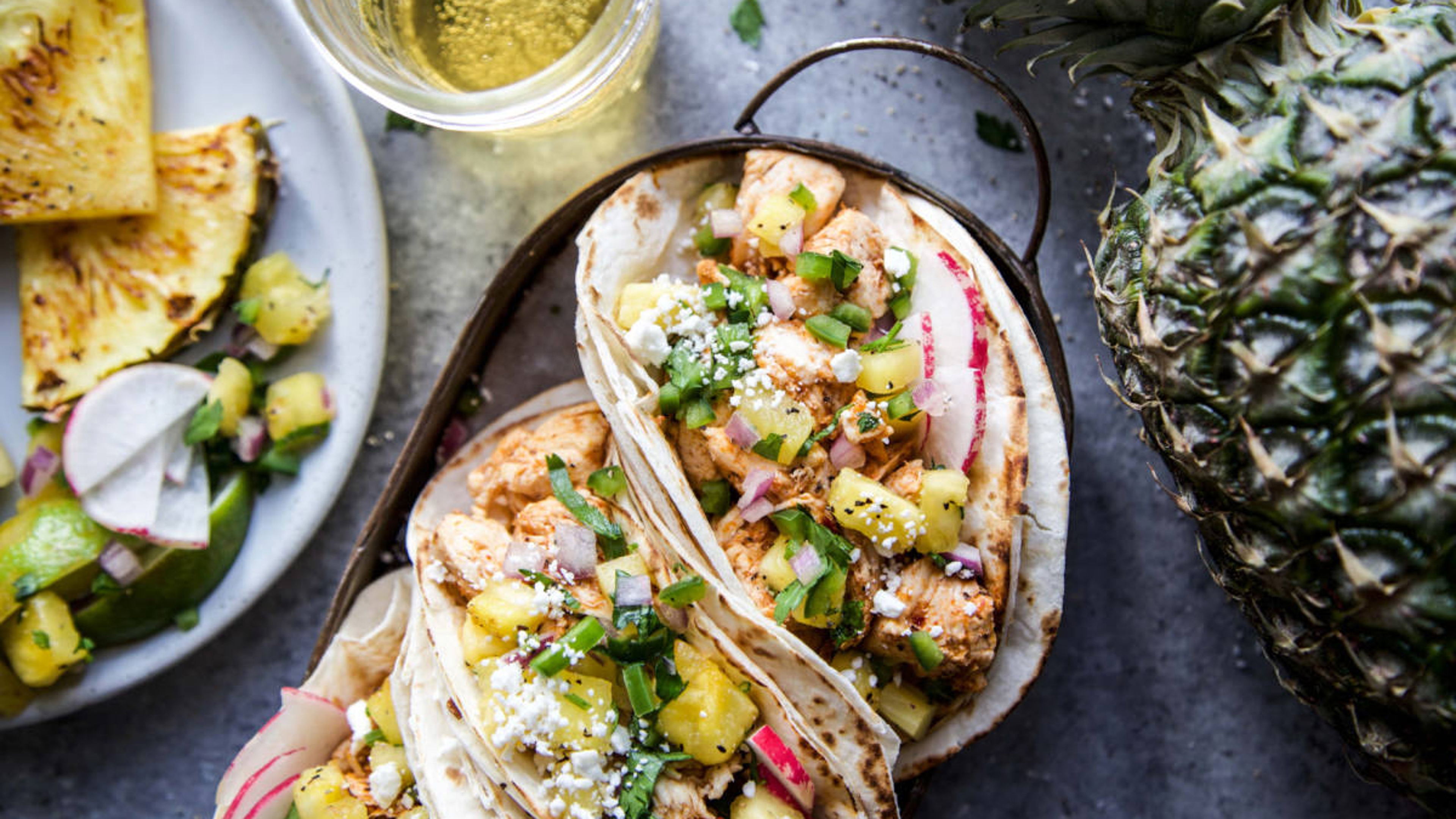12 Ways to Use Fruit
If eating fruit out of hand gets boring, keep reading for a dozen delicious and juicy ways to consume it.
Apr 08, 2025
Fruit provides essential antioxidants and phytochemicals, naturally occurring chemicals in plants that ward off and fight disease, boost our immunity, and help protect us from cancer and heart disease. The best way to reap their benefits is to “eat the rainbow” of seasonal fruits; each color, after all, is linked to different nutrients.
While eating fruit out of hand is the best way to get your daily dose of powerful protection, cooking, pureeing, drying, and blending fruit also make some of its beneficial nutrients — such as the rich red, orange-yellow pigment lycopene that is found in apricots, melons, peaches, and watermelon — more readily available for our bodies to absorb.
Besides eating fruit out of hand, here are a dozen more delicious, creative, and easy ways to invite nature’s sweetest offering into your kitchen.
1. Smoothies
1. Smoothies
Refreshing, customizable smoothies are a great way to enjoy fruit for breakfast or a snack. (Tip: Starting with a base of frozen banana, rather than ice, will give your smoothie a rich mouthfeel and keep it cold.) And with so many fruits to choose from — cherries, strawberries, mangoes, pineapple, and even whole citrus — you never have to have the same smoothie twice! Try an Orange Smoothie Creamsicle, a Fresh and Green Pineapple Smoothie, or a Chia Cherry Smoothie to kick-start your day!
2. Fruit Leather
2. Fruit Leather
Shop : Dried Fruit and Nut Tray from Harry & David
Snacking on store-bought fruit leather sounds like a great idea until you read the ingredients, which can include added high fructose corn syrup and partially hydrogenated oils. Plus, it can be expensive. Making fruit leather at home saves money, and, contrary to what you may have heard, requires no special equipment other than your oven. Turn apples and pears into fruit leather by creating a simple stovetop puree perfumed with the warm spices of cinnamon and cardamom.
Shop : Dried Fruit and Nut Tray from Harry & David
3. Dried Fruit
3. Dried Fruit
Removing water from fruit renders an intensely flavored, denser fruit with a long shelf life. Enjoying dried fruit for its satisfying chew and sweetness comes with a range of benefits, too: Dried apricots and prunes contain higher amounts of their beneficial micronutrients when dried, and many dried fruits, such as figs and raisins, will give you a boost of fiber. While all fruit contains natural sugar, removing water concentrates its sugars. Look for dried fruit that is not candied or has no added sweeteners. Sprinkle dried fruits among fresh fruit for your next cheese board for added texture, or snack on them as a sweet counterpart to crunchy nut mixes.
4. Salad dressings
4. Salad dressings
Shop : Oregold® Peaches from Harry & David
Adding fruit to homemade dressing is a great way to complement fruit add-ins, such as berries and citrus, to a leafy green or grain bowl — plus, creating a healthier, full-flavored dressing or vinaigrette is a fraction of the cost of the store-bought version. I love this warm Bacon Citrus Dressing over a leafy spinach, Honeybell orange, and strawberry salad, as well as a Peach and Balsamic Dressing for a grilled chicken salad bowl.
Shop : Oregold® Peaches from Harry & David
5. Easy fruit sauces (Coulis)
5. Easy fruit sauces (Coulis)
Drizzling fruit sauces, or coulis, over a slice of cheesecake, chocolate cake, or ice cream is a great way to elevate dessert. For a quick berry coulis: Combine a half cup of granulated sugar with 3 tablespoons of orange juice in a saucepan over medium heat until the sugar dissolves (it will be thick). Add 1 1/2 cups of any type of berry and stir. Blend into a smooth puree and pass the mixture through a fine mesh sieve to remove any seeds. Voila!
6. Fruit marinades
6. Fruit marinades
Fresh pineapple, kiwi, and papaya contain enzymes that tenderize meat, making them terrific for marinades. For an easy pineapple marinade: Combine 1 cup of fresh pineapple chunks, 3 tablespoons of soy sauce, 2 tablespoons of honey, and two garlic cloves in a blender and process until smooth. Pour the marinade over cubed meat, such as chicken or steak, and refrigerate for a minimum of one hour and up to overnight. Thread the cubes onto skewers for kebabs with a deliciously sweet and tangy depth of flavor.
7. Baby food
7. Baby food
Making homemade fruit purees for a baby’s first taste of food is a snap. First, steam firm, peeled fruits, such as apples, pears, and mangoes, so they retain the bulk of their nutrients. Next, add water, formula, or breastmilk to soften the fruit, then mash it with a fork or blend it in a blender for a smooth puree. Bananas and avocados are even easier to introduce, as they don’t require mashing. Your baby will benefit from the fiber and nutrients these fruits offer.
8. Fruit pickles
8. Fruit pickles
The same vinegar, water, sugar, and salt brine you use for cucumber pickles can be used for fruit. For a fast fruit pickle: Fill a quart-size mason jar with firm chunks or slices of fruit (or even whole berries, such as blueberries). Bring 1 cup of apple cider (or white vinegar), 1 cup of water, a half cup of granulated sugar, and 1 tablespoon of kosher salt to a boil in a saucepan. Pour the hot brine over the fruit, and add any spices you wish, such as cinnamon stick, cloves, ginger, or star anise. Seal the jar and refrigerate overnight. Enjoy fruit pickles with cheese, serve them alongside roasted meats, use them as a cocktail garnish, or toss them in a salad.
9. Fresh fruit preserves
9. Fresh fruit preserves
Spreadable jams (made from crushed fruit or purees) and preserves (made with whole or cut fruit pieces) are a handy way to prevent food waste when you have an overage of seasonal fruit on hand. (Marmalades, by the way, have a bitter rather than sweet profile, and are always made with citrus and their zest). Small-batch refrigerator jams and preserves are a breeze to make and don’t require canning equipment. I love using this recipe for plum jam as a template for other stone fruits, such as peaches and nectarines. Feel free to switch the cardamom for ginger.
10. Fruit pies and cakes
10. Fruit pies and cakes
Baking fresh fruit into desserts brings a range of options besides classic (and sometimes daunting) double crust apple, peach, and cherry pies. Any baker can learn to whip up fruit cobblers, crisps, crumbles, galettes, hand pies, stovetop slump (a no-bake version of a cobbler), and tarts. And cakes? Well, they are just as varied, with shortcakes and upside down cakes topping our list of favorite, easy ways to spin fresh fruit into a refreshing, exciting treat. And if you are pressed for time, baking whole apples or pears with brown sugar, granola, and maple syrup topping is simple, fast, and oh-so-yummy!
11. Homemade popsicles
11. Homemade popsicles
Refreshing fruit popsicles are a great way to use the season’s bounty. And with more natural fruit flavor and fruit pieces, they contain less sugar and have a more satisfying texture than the store-bought ones. Plus, they are totally customizable. If you don’t have popsicle molds, use paper cups or ice cube trays. Add a layer of crunch by tossing in crushed mixed nuts or granola.
12. Cocktails
12. Cocktails
Showcase fresh fruit and your bartending skills by creating homemade libations. Sangria, which uses wine plus chopped seasonal fruit — apples, pears, citrus, peaches, and berries — is a great place to begin. So are homemade fruit lemonades (try watermelon!) and purees (try strawberry!) that pair well with vodka or gin. Or create a whimsical seasonal Bellini with fruit puree and sparkling wine. Slice lemons, limes, oranges, pineapples, cherries, and berries for beautiful garnishes, too.
.svg?q=70&width=384&auto=webp)



















